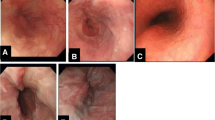Abstract
Purpose
To investigate (1) diagnostic performance of transabdominal color doppler ultrasound (US) and endoscopic ultrasound (EUS) for detection and sub-classification of common bile duct varices (CBDV) in patients with portal vein thrombosis (PVT), and (2) clinical significance and natural history of CBDV subtypes.
Patients and Methods
During a 4-year period, 56 patients with PVT underwent US and EUS for the presence and subtypes of CBDV. Natural history was analyzed for patients who attended control visits.
Results
CBDV were diagnosed in 57 and 59 % of patients with US and EUS, respectively. In 19 % of patients, EUS revealed different CBDV subtypes than previously seen by US. The most common were paracholedochal (PCV), while the least common were epicholedochal (ECV) and Submucosal varices (SMV). Nine patients had obstructive jaundice and underwent ERCP which was complicated by hemobilia in two patients with SMV. Among eight patients who underwent control EUS (median follow-up 60 months), the form of CBDV remained unchanged. Two patients bled from esophageal varices, both with ECV.
Conclusion
While abdominal US and EUS are equally sensitive for detection of CBDV, EUS allows more precise determination of CBDV subtype. Patients with SMV might be at increased risk of bleeding upon ERCP.





Similar content being viewed by others
Abbreviations
- CBD:
-
Common bile duct
- CBDV:
-
Common bile duct varices
- ECV:
-
Epicholedochal varices
- ERCP:
-
Endoscopic retrograde cholangiopancreatography
- EUS:
-
Endoscopic ultrasound
- EV:
-
Esophageal varices
- MRI:
-
Magnetic resonance imaging
- MSCT:
-
Multi-sliced computerized tomography
- PVC:
-
Paracholedochal varices
- PECV:
-
Para- and epicholedochal varices
- PVT:
-
Portal vein thrombosis
- SMV:
-
Submucosal varices
- US:
-
Abdominal ultrasound
References
Rajani R, Björnsson E, Bergquist A, et al. (2010) The epidemiology and clinical features of portal vein thrombosis: a multicentre study. Aliment Pharmacol Ther 32:1154–1162
Ponziani FR, Zocco MA, Campanale C, et al. (2010) Portal vein thrombosis: insight into physiopathology, diagnosis, and treatment. World J Gastroenterol 16:143–155
Amitrano L, Guardascione MA, Brancaccio V, et al. (2004) Risk factors and clinical presentation of portal vein thrombosis in patients with liver cirrhosis. J Hepatol 40:736–741
Bayraktar Y, Balkanci F, Ozenc A, et al. (1995) The “pseudo-cholangiocarcinoma sign” in patients with cavernous transformation of the portal vein and its effect on the serum alkaline phosphatase and bilirubin levels. Am J Gastroenterol 90:2015–2019
De Gaetano M, Lafortune M, Patriquin H, et al. (1995) Cavernous transformation of the portal vein: patterns of intrahepatic and splanchnic collateral circulation detected with Doppler sonography. AJR Am J Roentgenol 165:1151–1155
Corness JAG, McHugh K, Roebuck DJ, Taylor AM (2006) The portal vein in children: radiological review of congenital anomalies and acquired abnormalities. Pediatr Radiol 36: 87–96, quiz 170–1
Sharma M, Pathak A (2009) Intracholedochal varices in portal hypertensive biliopathy. Eur J Radiol Extra 72:e119–e123
Petren T (1932) The veins of the extrahepatic biliary system and their pathologic-anatomic significance. Vert Anat Ges 41:139–143
Saint JH (1961) The epicholedochal venous plexus and its importance as a means of identifying the common duct during operations on the extrahepatic biliary tract. Br J Surg 48:489–498
Senthil Kumar MP, Marudanayagam R (2012) Klatskin-like lesions. HPB Surg 2012:107519
Denys A, Hélénon O, Lafortune M, et al. (1998) Thickening of the wall of the bile duct due to intramural collaterals in three patients with portal vein thrombosis. AJR Am J Roentgenol 171:455–456
Grgurevic I, Buljevac M, Kujundzic M, et al. (2006) Common bile duct wall thickening due to intramural varices diagnosed by colour Doppler ultrasound. Ultraschall Med 27:483–486
Ozkavukcu E, Erden A, Erden I (2009) Imaging features of portal biliopathy: frequency of involvement patterns with emphasis on MRCP. Eur J Radiol 71:129–134
Palazzo L, Hochain P, Helmer C, et al. (2000) Biliary varices on endoscopic ultrasonography: clinical presentation and outcome. Endoscopy 32:520–524
Sharma M, Ponnusamy RP (2009) Is balloon sweeping detrimental in portal biliopathy? A report of 3 cases. Gastrointest Endosc 70:171–173
He Z-P, Fan L-J (2002) Diagnosis and treatment of portal biliopathy. Hepatobiliary Pancreat Dis Int 1:581–586
Shetty D, Bhatnagar G, Sidhu HS, et al. (2013) The increasing role of endoscopic ultrasound (EUS) in the management of pancreatic and biliary disease. Clin Radiol 68:323–335
Victor DW, Sherman S, Karakan T, Khashab MA (2012) Current endoscopic approach to indeterminate biliary strictures. World J Gastroenterol 18:6197–6205
Maruyama H, Okugawa H, Takahashi M, Yokosuka O (2013) De novo portal vein thrombosis in virus-related cirrhosis: predictive factors and long-term outcomes. Am J Gastroenterol 108:568–574
Choo L, Conway J, Mishra G (2012) The role of endoscopic ultrasound in biliary obstruction. Curr Gastroenterol Rep 14:520–527
Walser EM, Runyan BR, Heckman MG, et al. (2011) Extrahepatic portal biliopathy: proposed etiology on the basis of anatomic and clinical features. Radiology 258:146–153
Tsochatzis EA, Senzolo M, Germani G, Gatt A, Burroughs AK (2010) Systematic review: portal vein thrombosis in cirrhosis. Aliment Pharmacol Ther 31:366–374
Sharma M, Pathak A (2009) Perforators of common bile duct wall in portal hypertensive biliopathy (with videos). Gastrointest Endosc 70:1041–1043
Author information
Authors and Affiliations
Corresponding author
Rights and permissions
About this article
Cite this article
Grgurevic, I., Kujundzic, M., Banic, M. et al. Subtypes and clinical significance of common bile duct varices in portal vein thrombosis: diagnosis and follow-up by Doppler US and EUS. Abdom Radiol 41, 476–484 (2016). https://doi.org/10.1007/s00261-015-0596-4
Published:
Issue Date:
DOI: https://doi.org/10.1007/s00261-015-0596-4




